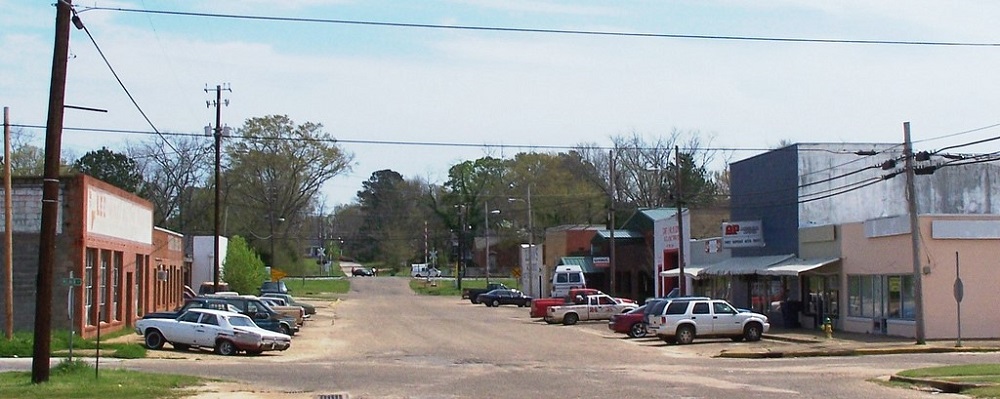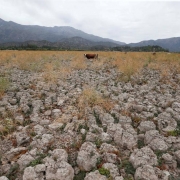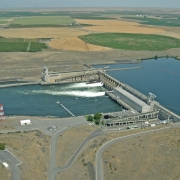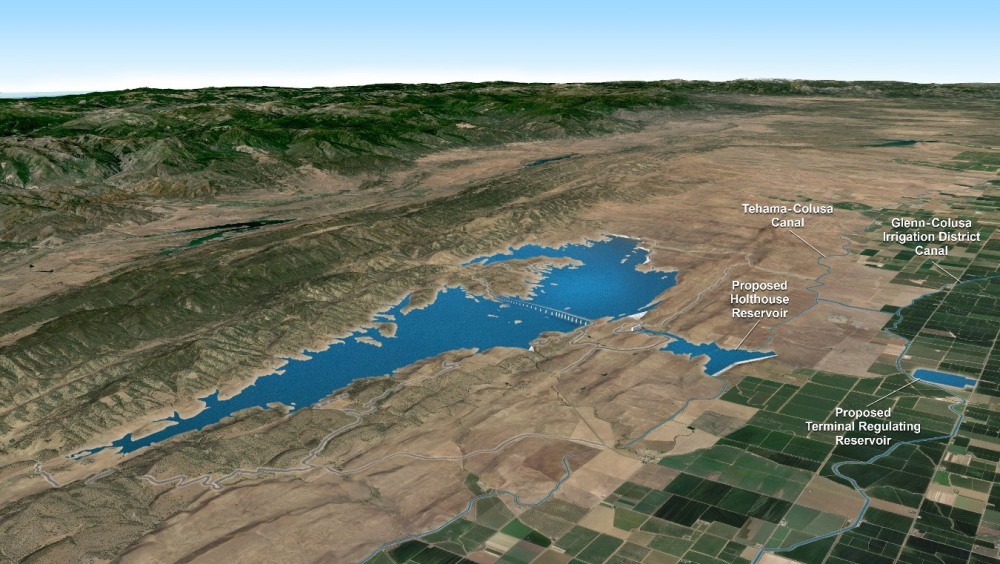Hookworm Infections and Sanitation Failures Plague Rural Alabama
New civil rights movement emerges around septic system pollution

Fort Deposit is a town of 1,200 people in Lowndes County, Alabama, where sanitation failures are spreading disease. Photo courtesy of Creative Commons / The Happy Rower
By Brett Walton, Circle of Blue
A measure of desperation and disease, parasitic infections caused by hookworms are seen by medical specialists as a powerful betrayal of civic progress. More than 700 million people worldwide, many of them children, are infected by a microscopic worm that left unattended causes serious anemia. In the United States, hookworm was prevalent in the Deep South around the turn of the 20th century until modern sewage treatment systems and better hygiene practices eradicated the scourge.
Or so it was thought.
In Lowndes County, Alabama, a young professor of infectious diseases named Rojelio Mejia has launched a “parasite expedition.” Mejia’s search comes in a part of the state, west of Montgomery, with failing septic systems, inadequate public financing for sanitation, isolated communities, poorly draining soils, and notorious humidity. The social and environmental conditions, in other words, form a perfect breeding ground for tiny organisms that lodge in the intestines of people.
“The whole source of infection is poor sanitation,” says Mejia, an assistant professor at Baylor College of Medicine.
“We have families, especially children, living and playing among raw sewage,” Catherine Flowers, the executive director of the Alabama Center for Rural Enterprise, and the leading advocate for sanitation in rural Alabama, told the Inter-American Commission on Human Rights, in Washington, D.C., in October. “This is the starkest form of inequality in this nation, and a blatant violation of the human right to clean water and sanitation.”
Poverty and Geography
The resurgence of intestinal parasites is a rebuke to Lowndes County’s long history of civic activism to improve the lives of its citizens. When they walked from Selma to Montgomery, the Alabama capital, in March of 1965 to campaign for voting rights, civil rights activists passed through 34 kilometers (21 miles) of Lowndes County. It was the midpoint of the five-day trek, but the passage through Lowndes was a powerful symbol of the marchers’ struggle.
In those days of racial violence and terror, 81 percent of the population of “Bloody” Lowndes — so named because of frequent lynchings and murders — was black. Yet none was registered to cast a ballot. Whites, by contrast, held disproportionate power. For every 100 in the county, more than 117 names appeared on voter rolls.
Today, the lack of basic environmental safeguards for public health and appalling inequality is rousing the next generation of campaigners. A new civil rights movement, one focused on sanitation, is emerging in central Alabama, with Lowndes at the center.
Like a mirror, poverty reflects outward. Economic stagnation and a residential exodus have crippled local government spending, especially for big public works projects. Handcuffed by tight budgets, few towns in the county could afford municipal facilities to transport and treat toilet waste without federal government aid. Lowndes’ open space — it is one of the least dense counties in Alabama — puts sewer expansions mostly out of reach for rural residents. Extending pipes that far is too expensive. Instead, many households use a septic system, which is an underground tank to trap solid waste and perforated piping to allow the liquid to soak into the soil.
But even the simplest of waste systems is coming apart. Half the households with septic have a failing system, or worse, no means of waste disposal at all besides a pipe directed at the back yard, according to the Alabama Center for Rural Enterprise. The soil is partly to blame. Dense clay hardpan in south-central Alabama, which lends the region its Black Belt nickname, does not allow water to drain easily. Contaminated water pools on the surface and mars the county’s lowlands, where it becomes a breeding ground for parasites.
The shortcomings in Lowndes have long been known to health campaigners. The Alabama Department of Public Health began citing residents in 1999 for dumping raw sewage in backyards. Then in 2011 the county was highlighted in a United Nations report on failures to provide adequate drinking water and sanitation in the United States.
Public officials in Lowndes say that progress is coming, albeit slowly. A handful of towns received federal grants recently for sewer system expansions and cheaper alternatives to sewers are being investigated. Surmounting the structural hurdles, however, will not be easy. Poverty and demographic declines are hard to reverse, as the digital revolution concentrates wealth and the political fashion for austerity drives down budgets. In this, Lowndes may be an extraordinary example but it is hardly alone. Poverty and political impotence has deprived many American communities of a hot shower and sanitary treatment — in urban Detroit and Baltimore as well as in the rural Rio Grande Valley and Navajo Nation.
Understanding the Problem
Flowers is not the only person staggered by the inequality in Lowndes. In the winter of 2011, Catarina du Albuquerque, then serving as the United Nations’ independent expert on drinking water and sanitation, visited the United States to report on the right to water. She heard testimony from Lowndes County representatives, including Flowers, who explained the sanitation failure.
Mejia, too, was surprised by what he found when he visited Lowndes.
“I’ve traveled all over the world and seen a lot of slums where conditions are similar to what I saw in rural Alabama,” Mejia told Circle of Blue. “A lot of homes can’t use a regular septic system because of the soils. They have a straight pipe that runs twenty to thirty feet and dumps into the hills. It rains and then it floods.”
Mejia’s study looks at the health of 55 people and the composition of 34 soil samples. He said it is a first attempt to understand the magnitude of the hookworm problem today.
“I don’t know about infection rates,” he said, referring to the percent of the population with a disease. “We need to test again and do continuous testing to see what’s going on. First we assess the prevalence: what’s there. Next we’ll assess the impact on humans.”
Necator americanus and Ancylostoma duodenale are the two species that infect humans. The larvae are microscopic, able to penetrate skin without triggering a yelp or shriek. The pain comes later. The worms, having coursed through the circulatory system, hook themselves to the intestinal wall and interfere with blood transport, which causes anemia and fatigue. Children are at risk of stunted growth or brain impairments.
The hookworm lifecycle continues outside the body as the eggs are deposited in feces. If a septic system leaks or if a household pipes its waste to the backyard, the parasite can survive the soil. Lowndes and other counties in Alabama’s Black Belt are at higher risk because of the poorly draining clay soils and the region’s notorious humidity.
Mejia did not want to release the results because the study is still undergoing peer review.
Gathering data was a challenge, Mejia said. The researchers had to overcome deep-rooted skepticism of an outsider toting a notepad. Not having a means of treating and disposing of sewage is illegal. Some families have been fined by state and county health departments, arrested, or threatened to have children taken away because of inadequate sanitation.
To ease fears, Mejia enlisted Flowers as his guide and confidante. He is impressed by her dedication to bring attention to the issue.
“It’s amazing what she’s done,” Mejia said of Flowers. “It’s a big problem and easy to forget. In rural areas, they don’t usually have a voice.”
Poverty Limits Options
Flowers is one of many people working on a solution, nearly all of which require the flow of outside money.
“The communities don’t have the funds for wastewater treatment,” Flowers told Circle of Blue. “They have no resources for that. They are leaving it to the homeowner.”
Homeowners often do not have the means either. A new septic system may cost a third or more of a household’s annual income.
A few towns have received federal support recently to expand sewer systems. Hayneville, the county seat, secured a $US 342,210 grant from the U.S. Department of Housing and Urban Development in 2013 to upgrade a sewer system that was installed in the 1980s. Mosses, a smaller town, received $US 350,000 from the Alabama Department of Economic and Community Affairs in 2012 to connect 90 homes to a sewer.
Sewers are expensive, though, and securing funding has become more difficult because of federal budget cuts. In 1982, the first year of the Community Development Block Grant small cities program, Alabama received $US 31.7 million ($US 78.1 million in 2015 dollars) to distribute to communities like Mosses. This year, after a steady downward slide, the state received $US 21.5 million, according to Shabbir Olia, unit chief for the Alabama Department of Economic and Community Affairs, which handles federal grants.
“If there is no money, what do you do?” Olia asked. “There aren’t too many ways to address it. State funding is going down too.”
Flowers is hoping that a competition to design affordable, small-scale treatment units that work in the Black Belt soil will bear fruit. The competition begins next year. The winners could help not just Lowndes but the state as a whole. An American Society of Civil Engineers analysis released this month claims that one-quarter of the septic systems in Alabama are failing.
Others are tired of talking about the problem. Helenor Ball, economic development director for Hayneville and the town’s mayor from 2004 to 2012, is one. She wants action.
“We get calls from colleges and universities that want to study us but I would like to see the money go into projects on the ground, where residents need it,” Ball told Circle of Blue. “We’ve been talking about this problem for years. We know what needs to happen. If money is going to be spent, we need money for infrastructure. If someone is able to continually point out an issue, let’s use some of the funds to actually help residents.”
Help is trickling in, grant by grant, Tyson Howard of the South Central Alabama Development Commission, argues. It’s just coming slowly and dependent on shrinking state and federal budgets.
“We’re making progress, but it’s piecemeal,” Howard said. “We still have a ways to go.” One day, perhaps, reaching justice.
Brett writes about agriculture, energy, infrastructure, and the politics and economics of water in the United States. He also writes the Federal Water Tap, Circle of Blue’s weekly digest of U.S. government water news. He is the winner of two Society of Environmental Journalists reporting awards, one of the top honors in American environmental journalism: first place for explanatory reporting for a series on septic system pollution in the United States(2016) and third place for beat reporting in a small market (2014). He received the Sierra Club’s Distinguished Service Award in 2018. Brett lives in Seattle, where he hikes the mountains and bakes pies. Contact Brett Walton










Leave a Reply
Want to join the discussion?Feel free to contribute!